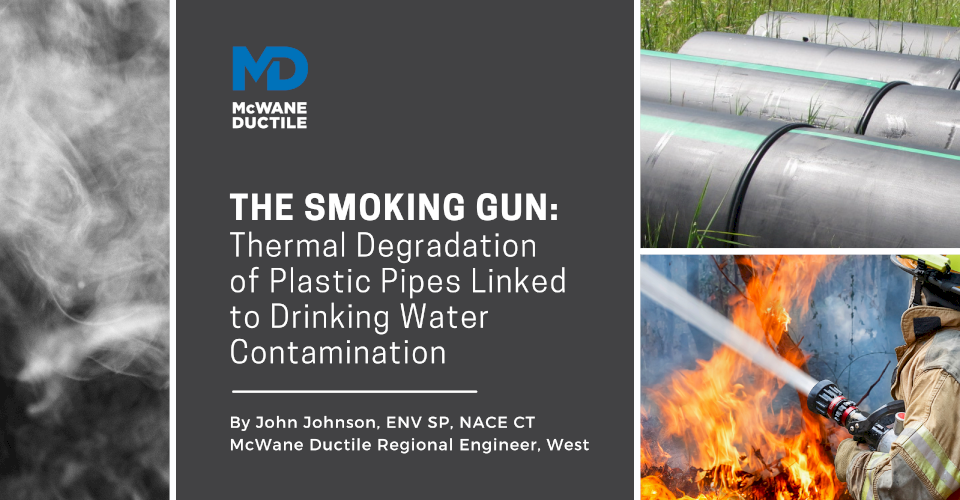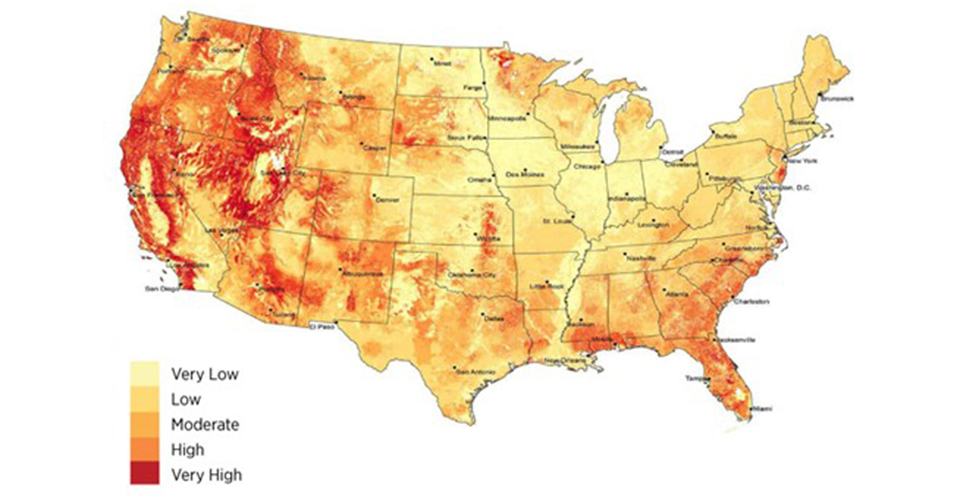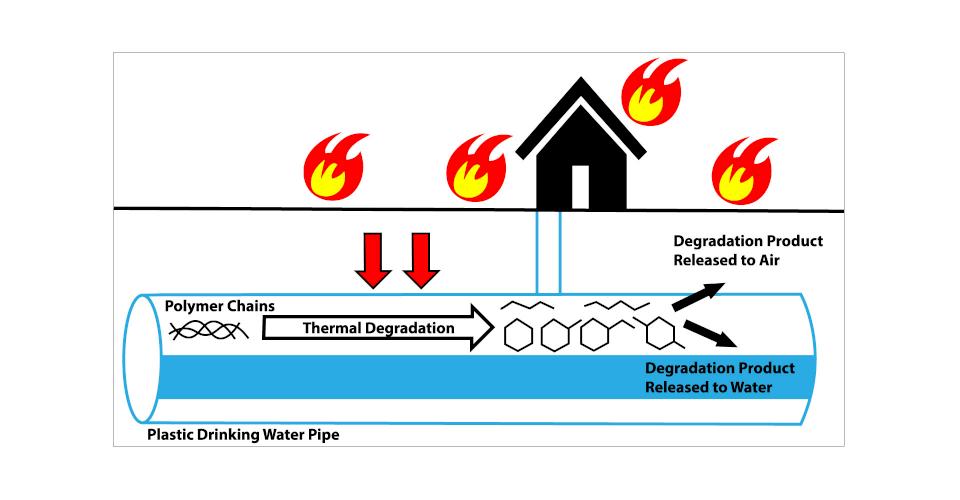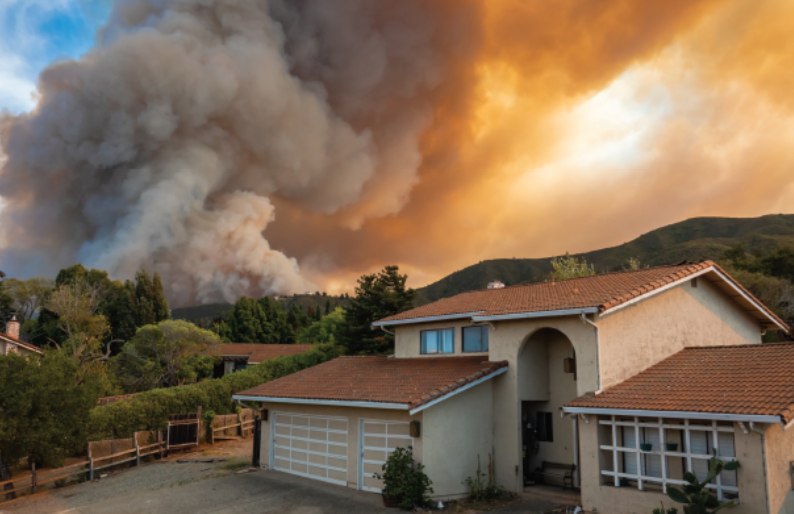As of October 2020, more than 47,000 wildfires have occurred across 36 U.S. states. Drought is a major factor, as a large portion of the West is currently experiencing the most severe level of drought, dubbed “exceptional drought” by the U.S. Drought Monitor. Humans cause the majority of wildfires with negligence such as unattended campfires, discarded cigarettes or arson, followed by natural causes such as unusually long-lasting hot lightning bolts. (U.S. Drought Monitor, 2012)
Wildfire Risk
Recent research reveals new information on the dangers of drinking water contaminated by PVC (polyvinyl chloride), HDPE (high-density polyethylene) and CPVC (chlorinated polyvinyl chloride) plastic pipes as a result of many of these wildfires. This new research adds to decades of previous studies on plastic pipes documenting the significant environmental impact, lack of sustainability, shorter design life, higher pumping costs and dependence upon man-made petrochemical resins versus natural elements. This impact is in addition to the inherent risk of drinking water contamination from permeation through plastic pipes.
A research study published in “Environmental Science and Water Research Technology” by Andrew J. Whelton, Ph.D. et al. (2021) documents drinking water contamination from thermal degradation of plastic pipes, and it revealed an even greater danger to drinking water from plastic pipes. The results indicated that when plastic pipe materials are exposed to elevated temperatures, Benzene, a known carcinogen, and other volatile organic compounds (VOCs) and semi-volatile organic compounds (SVOCs) are leached into drinking water.
The heat from wildfires or structure fires can thermally damage buried plastic mains, resulting in water contamination. Not only does plastic pipe release hazardous contaminants into a drinking water system, but it also acts as a sink, absorbing benzene and organic contamination when negative pressures or main breaks draw smoke from the fire into the distribution system.
The potential for watermain damage increases significantly because of the low melting point for PVC and HDPE pipe materials. Low melting levels also endanger a community’s ability to combat fires when melting mains can no longer provide vital firefighting flows. In addition, gaseous fumes from burning plastics have also hindered and obstructed firefighting efforts in certain circumstances. This article recaps key findings from the study and illustrates the real contamination dangers plastic pipes pose to drinking water quality.
Higher strength, longevity, superior resistance to mechanical damage, corrosion resistance with coatings, and fire resistance are just some advantages of Ductile Iron Pipe over HDPE Pipe! Use this handy comparison sheet to ensure you select the proper pipe for your next project.
Wildfires’ Impact on Buried Plastic Pipe
“Over the years, wildfires have crept out of the wild and into urban landscapes, threatening more lives, property, and infrastructure than ever before, sometimes devastating communities.”² In the aftermath of the 2017 Tubbs Fire in Santa Rosa, California, and the massive 2018 Camp Fire in Paradise, California, engineering experts from Purdue University and Manhattan College investigated the drinking water contamination of below-ground and above-ground drinking water infrastructure.
Tests of below-ground distribution systems revealed the presence of a variable mix of VOCs, including benzene, toluene, dichloromethane and styrene. Testing at Santa Rosa Water revealed benzene was found in concentrations as high as 40,000 ppb and at more than 2,217 ppb after the Camp Fire. In California, the maximum contaminant limit for Benzene is one ppm, and the federal limit is five ppm. Levels at or above 500 ppb are characteristic of hazardous waste.
Chronic exposure has been linked to various cancers as well as reproductive and blood disorders. Infants and children are extremely vulnerable and may experience health effects at lower levels than adults because of their smaller mass. Since some of the contamination is volatile, heating or boiling contaminated water can transfer the chemicals from water to air. Chronic exposure can occur through bathing, personal hygiene, drinking or cooking. For 11 months, Santa Rosa Water issued a do-not-drink/do-not boil advisory.
Contamination Testing and Results
The Whelton study tested 11 plastic pipe samples across eight common brands in the waterworks industry, all NSF 61 approved. Samples were exposed to a range of elevated temperatures from 200˚C to 400˚C (392˚F to 752˚F). Results revealed the PVC and CPVC were more susceptible to thermal degradation than other pipe materials at 300˚C and 316˚C (572˚F and 600˚F). PVC showed the most significant measure of leaching at 300˚C (572˚F). HDPE showed significant degradation at 463˚C (856 ˚F) and greater than 478˚C (892˚F).
The general trend of compound concentration leaching across plastics was benzene > toluene > ethylbenzene > xylene. Benzene and toluene formed during the first stage of decomposition of PVC and CPVC materials. Ethylbenzene and xylene formed during the second degradation step. VOC released from HDPE also developed during the second degradation step. BTEX (benzene, toluene, ethylbenzene and xylene) was leached from 10 of the 11 samples, and greater BTEX concentrations were found as degradation temperature increased.
Below: Images of fire-damaged water system components including (a) an HDPE plastic pipe, (b) a water meter, and (c) a water meter cover following the Camp Fire. Thermally degraded pipe samples in laboratory experiments include (d) PEX-c pipe degraded at 300°C, (e) HDPE pipe degraded at 300°C and (f) HDPE pipe degraded at 400°C.
Results of the Study
Results from the Whelton study document the direct link between commercially available plastic pipes and the generation of known carcinogens
(BTEX) when exposed to elevated temperatures — in concentrations above short- and long-term state and federal limits. Further, BTEX that remains in cooled products ultimately leaches into drinking water, causing contamination. Remediation of contaminated plastic pipes is also problematic.
“According to models developed by the U.S. Environmental Protection Agency, it could take as many as 195 days of constant flushing to reduce 20 ppb to less than .5 ppb from a single HDPE pipe. Moreover, replacing certain pipes may be more effective in terms of cost and time than flushing contamination out, as both the City of Santa Rosa and Paradise Irrigation District (PID) discovered.”
What are the differences and advantages of Ductile iron over PVC pipe? Many things! Use this handy comparison sheet to ensure you specify the safest, durable, and longest-lasting pipe for your next project.
Conclusion and Solution
The results documented by Whelton and other reputable research organizations provide the smoking gun that a serious problem exists with using synthetic materials for drinking water infrastructure. This problem threatens both the health and safety of our communities.
So, what is the solution? I highly recommend that those selecting pipe material dig deep into the pros and cons of each option. I am confident your research will ultimately lead you to data detailing Ductile iron’s ability to “take the heat.”
With 13 times the impact strength of other materials, greater flow capacity equating to 38% more energy efficiency and an anticipated service life of 100-plus years, the clear choice for a safe, resilient and sustainable distribution system is the proven pipe material forged by fire to withstand fire — iron strong Ductile iron pipe.
For more information on the advantages of Ductile iron over plastic piping, please visit McWane Ductile’s Iron Strong Blog where you can access these helpful articles:
- The Advantages of Ductile Iron Over PVC by Jerry Regula
- Differences that Matter — HDPE and DI Pipe — A Comparative Narrative by Ken Rickvalsky
- How to Protect Water Quality from Permeation Due to Contaminated Soils by John Johnson
- Why Should I Use Ductile Iron Pipe? Four Key Considerations by Roy Mundy
Need Assistance with Your Waterworks Project?
If you have any questions regarding your water or wastewater infrastructure project, be sure to reach out to your local McWane Ductile representative. We have team members who've managed small and large water utility systems, served in engineering consulting firms, and bring decades of experience in solving field issues involving pipeline construction and operation. From design to submittal, to installation, we strive to provide education and assistance to water professionals throughout the water and wastewater industry.
Check Out All Our Digital Offerings
References
- Caitlin R. Proctor, Ph.D., Andrew J. Whelton, Ph.D., Amisha D. Shah, Ph.D. et al., “Fire and Water,” Civil Engineering, Jan/Feb 2021.
- P. Isaacson, C.R. Proctor, Q.E. Wang, E.Y. Edwards, Y. Noh, A.D. Shah, and Andrew J. Whelton, “Drinking Water Contamination from the Thermal Degradation of Plastics: Implications of Wildfire and Structural Fire Response,” Environmental Science -Water Research & Technology, Royal Society of Chemistry, 2021,.
- S. Drought Monitor, “US Drought Map: Released June 3, 2021,” Accessed June 9, 2021, https://droughtmonitor.unl.edu/.
- R. Proctor, J. Lee, D. Yu, A. D. Shah, and A. J. Whelton, “Wildfire Caused Wide-Spread Drinking Water Distribution Network Contamination,” AWWA Water Sci., 2020, 1–14, DOI: 10.1002/aws2.1183.
- National Academies of Sciences Engineering and Medicine, “Implications of the California Wildfires for Health, Communities, and Preparedness,” 2020, DOI: 10.17226/25622.
- San Lorenzo Valley Water District, Benzene Detection at Creek Drive in Riverside Grove, Boulder Creek, California, 2020, available from: https://www.slvwd.com/sites/g/files/ vyhlif1176/f/uploads/benzene detection at creek dr swrcb approved_9.9.2020.pdf.
- County of Santa Cruz, Water Wells and Springs, Santa Cruz, California, 2020, available from: https://www.santacruzcounty. us/Portals/6/Env Health/CZU Fire/WaterWellFireReturn.pdf.
- Paradise Irrigation District, 2019 Paradise Annual Consumer Confidence Report, Paradise, California, 2019, available from: https://pidwater.com/docs/about-your-water/water-quality/ 1750-2019-consumer-confidence-report/file.
- State Water Resources Control Board, “Information to Water Customers Regarding Water Quality in Buildings Located in Areas Damaged by Wildfire,” August 9, 2019, Accessed 6-1-21, https://www.waterboards.ca.gov/drinking_water/.
- Whelton and T. Nguyen, Contaminant Migration from Polymeric Pipes Used in Buried Potable Water Distribution Systems: A Review, Crit. Rev. Environ. Sci. Technol., 2013, 43(7), 679–751, DOI: 10.1080/10643389.2011.627005.
-
K.P. Isaacson, C.R. Proctor, Q.E. Wang, E.Y. Edwards, Y. Noh, A.D. Shah, and Andrew J. Whelton, Drinking Water Contamination from the Thermal Degradation of Plastics: Implications of Wildfire and Structural Fire Response, 2021, Environmental Science -Water Research & Technology, Royal Society of Chemistry.













